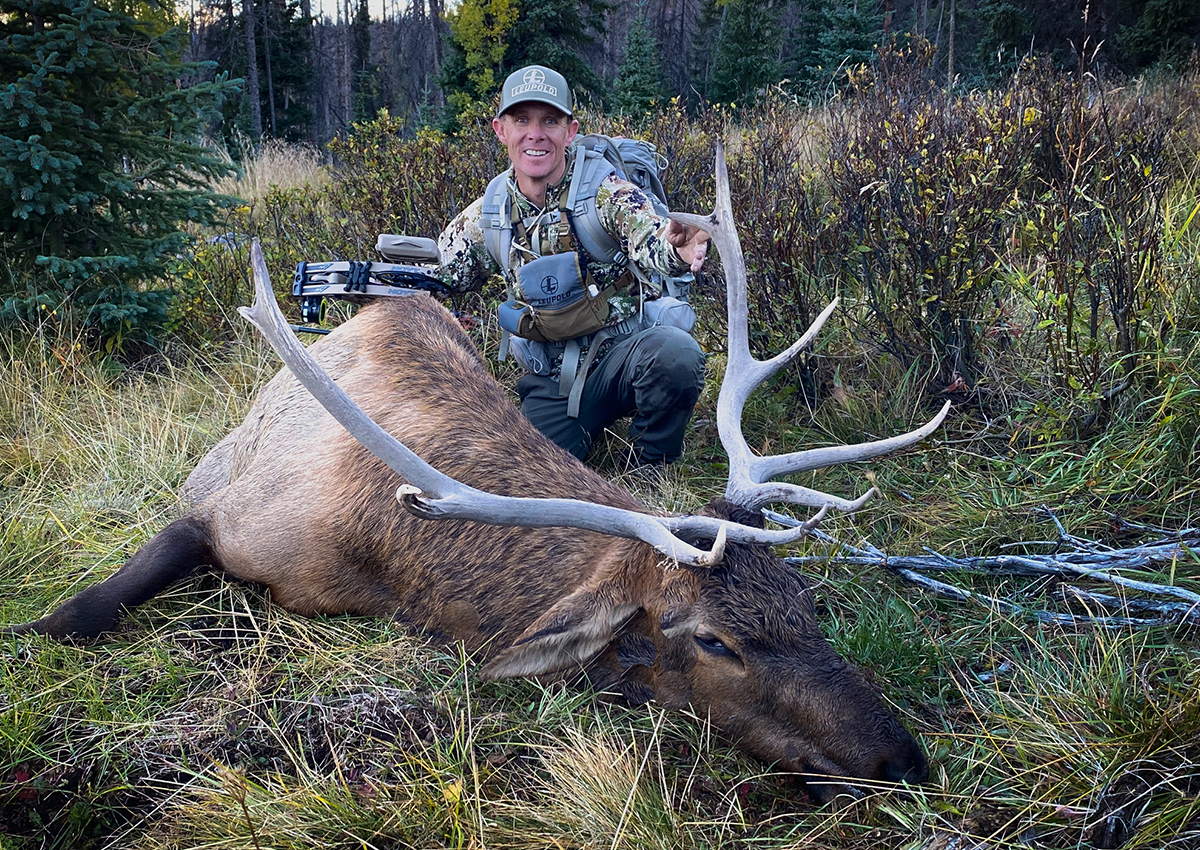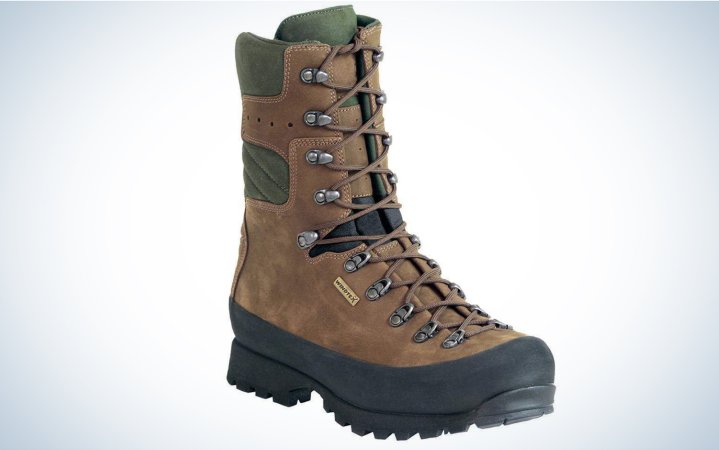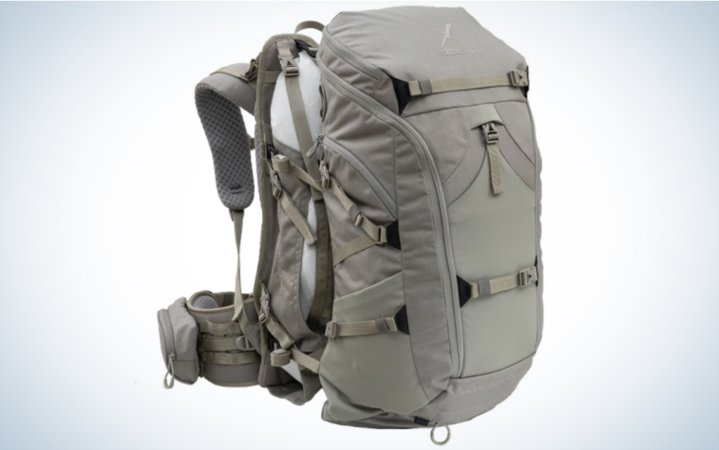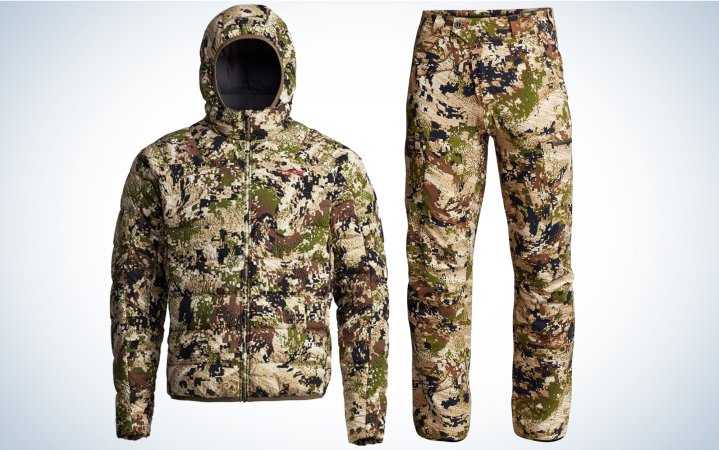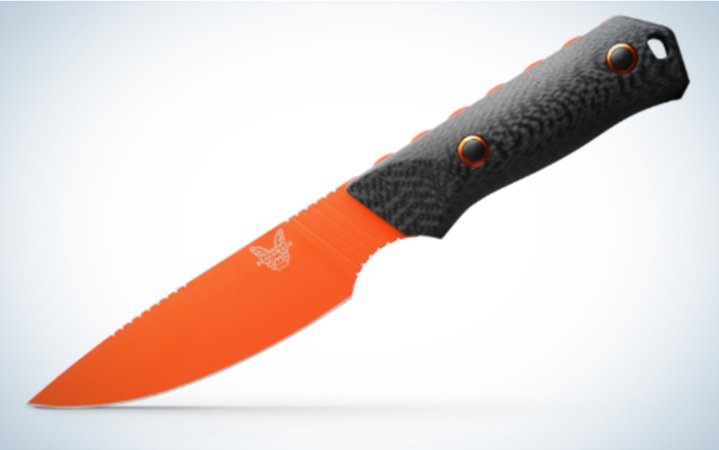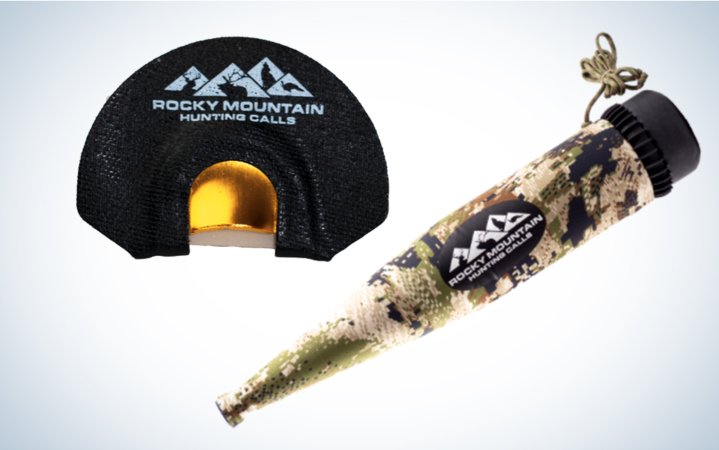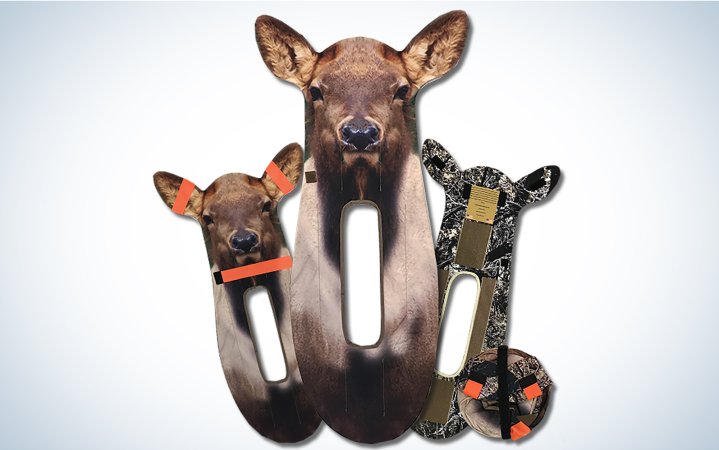We may earn revenue from the products available on this page and participate in affiliate programs. Learn More ›
I’ve chased elk across the West for over 20 years. During that tenure, I’ve learned a lot about the best gear for elk. Elk hunting often occurs in remote, unforgiving landscapes. The gear you decide on can mean the difference between staying on the mountain and punching out early. And, not to get dramatic, but gear can mean the difference between life and death.
There was the tent I was sleeping in that golf ball-sized hail destroyed while I was inside. That made for a painful, exciting night. I took a beating and had to come off the mountain early. I had a small cook stove that wouldn’t ignite above the timberline, which meant a mix of trail mix and granola bars for a week. I’ve had boots rub my feet raw, and trekking poles snap, backpack zippers fail, and the list of gear failures goes on.
Today, I have a proven system of gear that I know won’t fail me, from the cedar-choked canyons of the southwest to the foothills to the awe-inspiring Rockies. My picks for the best elk hunting gear have proved their worth time and time again.
- Best Boots: Kenetrek Mountain Extreme 400
- Best Backpack: ALPS Elite Frame + 3800 Pack
- Best Clothing: Sitka Kelvin Lite Down Jacket and Ascent Pant
- Best Tent: Alps Mountaineering Tasmanian 2-Person
- Best Knife: Benchmade Raghorn Carbon Fiber
- Best Calls: Rocky Mountain Hunting Calls Wapiti Whacker Bugle Tube and Black Magic GTP Diaphragm
- Best Decoy: Ultimate Predator Stalker Elk Decoy
How I Chose the Best Elk Hunting Gear
None of what you’re about to read is snake oil. I didn’t use this gear in my backyard and slug it with a “Best” label. That would be gross. This gear is battle-tested in extreme elk environments and always wins.
I know how serious elk hunters are, and I want to recommend gear that I have used and abused, and that’s what you’ll find in this article. If I mention it, you can trust it.
However, it’s essential to explore. Talk to as many elk gurus as you can. Watch gear tutorials on Youtube, and reach out to wapiti kingpins on social media—not the celebs, but the elk hunters that get it done on public dirt on their own every year. Once you get a gear arsenal that you know is second to none, you’ll gain more confidence to wander further and hunt longer.
Best Elk Hunting Gear: Reviews & Recommendations
Best Boots: Kenetrek Mountain Extreme 400
Best Boots
Kenetrek Mountain Extreme 400
Pros
- Tall
- No seams down the tongue for abrasion resistance and waterproofness
- Reinforced double and triple stitching in high-wear areas
- Reinforced rubber sole guard
- Windtex waterproof breathable membrane
Cons
- A little on the heavy side
- Pricey
Key Features
- Sizes: Men’s 8 to 13
- Wide, narrow, and medium widths
- 10-inch tall leather uppers
- 2.8 mm premium full grain leather
- One-piece vamp construction
- 7mm nylon midsoles
- Anti-corrosion hardware
- 400 gram Thinsulate
I start with boots, and so should you. Please don’t skimp on quality elk hunting boots because of the sticker shock. You’ll pay for excellent boots, but they keep you on the mountain and make your feet feel like they’re in a top-tier pair of running shoes. My top boot go-to is Kenetrek’s Mountain Extreme 400.
Though I recommend you put some miles on them before your hunt, the Mountain Extreme 400s require no break-in period. I’ve never had a hotspot or a blister, and I love the aggressive K-Talon outsoles. The outsoles grab any terrain, and the 7 mm nylon midsoles give extra support when you’re toting a heavy load on your back.
I have also found that 400 grams of Thinsulate is ideal for most elk hunts, even those that stretch into late October. The boots breathe well and are waterproof. Best of all, though, is their durability. If you treat the boots a couple of times each year with Kenetrek’s waterproofing boot wax, these boots will serve you well for many seasons.
Best Backpack: Alps Elite Frame + 3800 Pack
Best Backpack
ALPS Elite Frame + 3800 Pack
Pros
- Lightweight
- Remarkably strong and durable
- Water-resistant
- Adjustable lashing system
- Six-position torso adjustment
- Load lifters and anti-sway belt straps
- Easy to take pack on/off the Elite frame
- Spacious
- Zippers along both sides for right-now access
Cons
- Would like to see a larger pack made available
Key Features
- Capacity: 63 liters (3,800 cubic inches)
- Frame Dimensions: 24 inches x 12.5 inches
- Main Compartment Dimensions: 27 inches tall x 12.5 inches wide x 9.5 inches deep
- Torso Range: 14 to 20 inches
- Waist Belt Range: 31 to 55 inches
- Weight: 5 pounds 13 ounces
- PU coated 500D
- Waist belt MOLLE system with removable hip pockets
- Rifle and bow drop-down pocket
- Hydration compatible with two side-outlet ports
- Rain cover is stowed in a zippered pocket on the bottom of the pack
This one will surprise many of you, but please remember that I’ve used Mystery Ranch, Stone Glacier, and other top-tier packs. While Mystery Ranch and Stone Glacier make remarkable packs, Alps’ Elite Frame + 3800 Pack is my number one elk pack.
Coming in at around 6 pounds, this pack offers infinite adjustment, and whether the pack is light or loaded down with elk meat and horns, it travels well with the hunter. The waist belt doesn’t rub on the hips, the 3D air mesh suspension lets the back breathe, and the anti-slip lumbar pad provides extra support.
The main compartment has zippers along both sides that run the full length of the main bag, which allows me to get the gear I need when I need it without having to perform a bag dump. I love the waist-belt pockets, and the lightweight PU-coated material dries quickly.
The bag separates off the pack frame in seconds, which makes adding meat to the frame and then pulling the pack up over the meat and reattaching very easy.
Read Next: Best Hunting Backpacks
Best Clothing: Sitka Kelvin Lite Down Jacket and Ascent Pant
Best Clothing
Sitka Kelvin Lite Down Jacket and Ascent Pant
Pros
- Lightweight
- Extremely durable
- Polygiene odor control technology
- Warm
- Breathable
- Purposeful pockets
- Hold up in any weather in any environment
Cons
- Price
Key Features (Kelvin Lite down jacket)
- Weight: 17 ounces (large)
- Sizes: Medium to XXL
- Down Weight: 110 grams
- Insulation: 900 fill PrimaLoft Gold Down Blend
- Arms and Lower Back Insulation: 60 grams of PrimaLoft Gold Active Synthetic.
- Two-way stretch nylon face
- Two zippered hand pockets
- Zippered chest pocket
- Colors: Optifade Subalpine, Optifade Open Country, and solids
I’ve tested lots of different elk hunting garbs, and for me, nothing trumps Sitka. My elk go-to is the Kelvin Lite down jacket and Ascent pant. This combo provides an athletic fit, a warm but breathable feel, and second-to-none durability. I also love that both garments feature Polygiene odor control technology, which is engineered to neutralize odor caused by sweat.
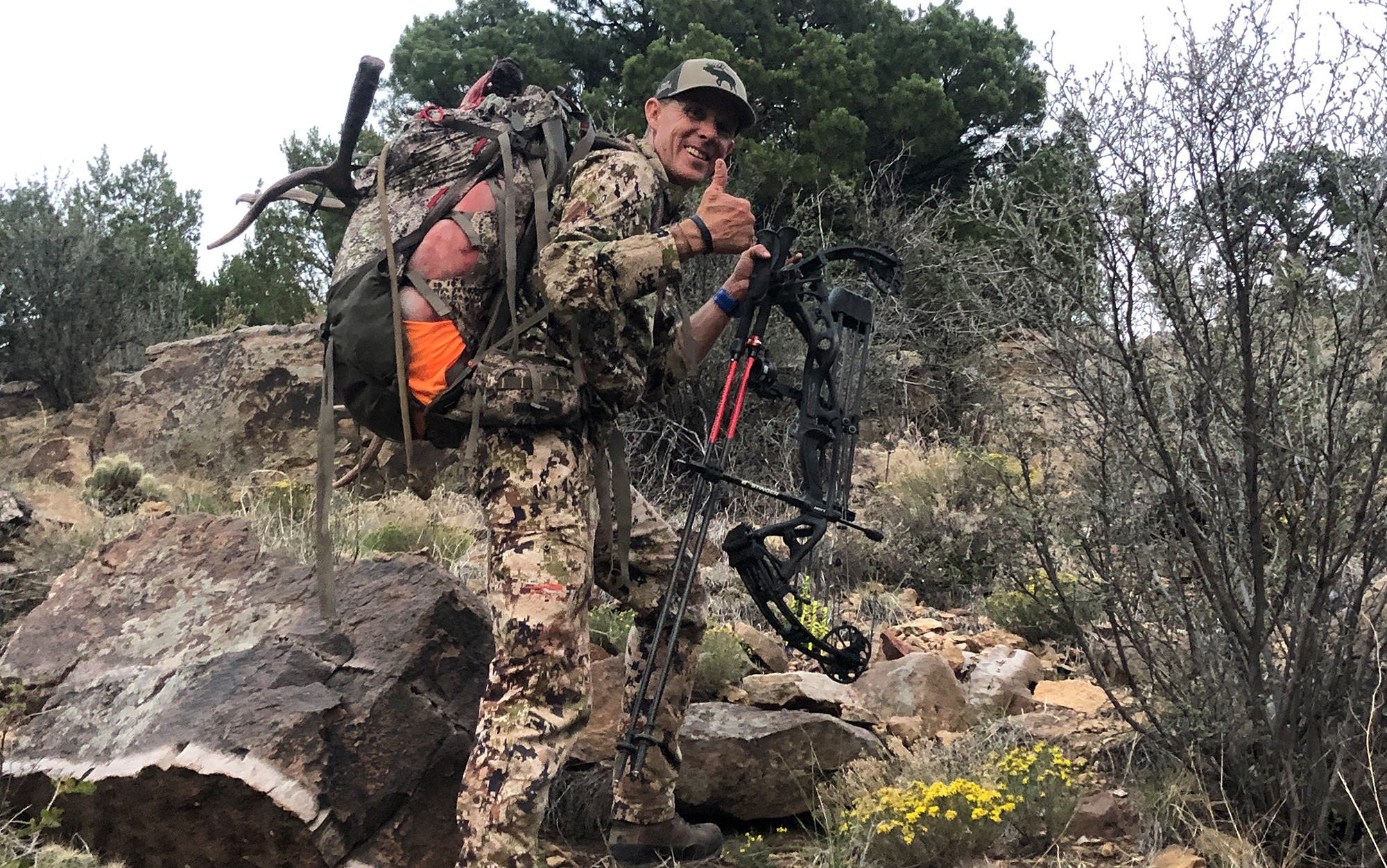
From the early season through October, the 17-ounce jacket is my number one go-to item. I layer with one of Sitka’s Core Midweight items and use the Kelvin as my outer layer. You can’t beat its comfort and warmth, and when I need to shed it, the Kelvin stuffs into my backpack with ease and takes up very little room. The pants have zero insulation, but I wear Sitka’s Heavyweight Bottoms under my Ascent Pants when insulation is needed. Four-way stretch synthetic material moves with the body and feels remarkable against the skin. The pants resist moisture and dry in seconds. All of the pockets are purposeful. You can’t go wrong with this dynamic duo.
Read Next: Sitka Women’s Ambient Review
Best Tent: Alps Mountaineering Tasmanian 2-Person
Best Tent
Alps Mountaineering Tasmanian 2-Person
Pros
- Durable poles
- Resists UV damage
- Free-standing pole system
- Rapid assembly
- Keeps all weather out
- Two vestibules provide extra storage and added weather protection
Cons
- I can’t even make one up
Key Features
- Base Size: 7 feet, 8 inches long x 5 feet, 2 inches wide
- Center Height: 3 feet, 10 inches
- Vestibule Depth: 2 feet, 11 inches
- Tent Area: 34.5 square feet
- Vestibule Area: 13 square feet
- Total Weight: 7 pounds, 15 ounces
- Packed Size: 1 foot, 9 inches long x 6.5 inches wide
- Pole Diameter 8.5 mm aluminum
- Four-season tent
- 75D 185T polyester fly with 1500mm coating
- 75D 185T poly taffeta floor with 5000mm coating
Your sleep shelter needs to be a good one. I’ve had miserable nights in the elk woods because my tent was garbage. Today, my number one elk tent for backcountry elk hunting is the Tasmanian 2-Person from Alps Mountaineering. The shelter goes up in seconds, and its four-season build stands up against snow, rain, hail, and violent winds.
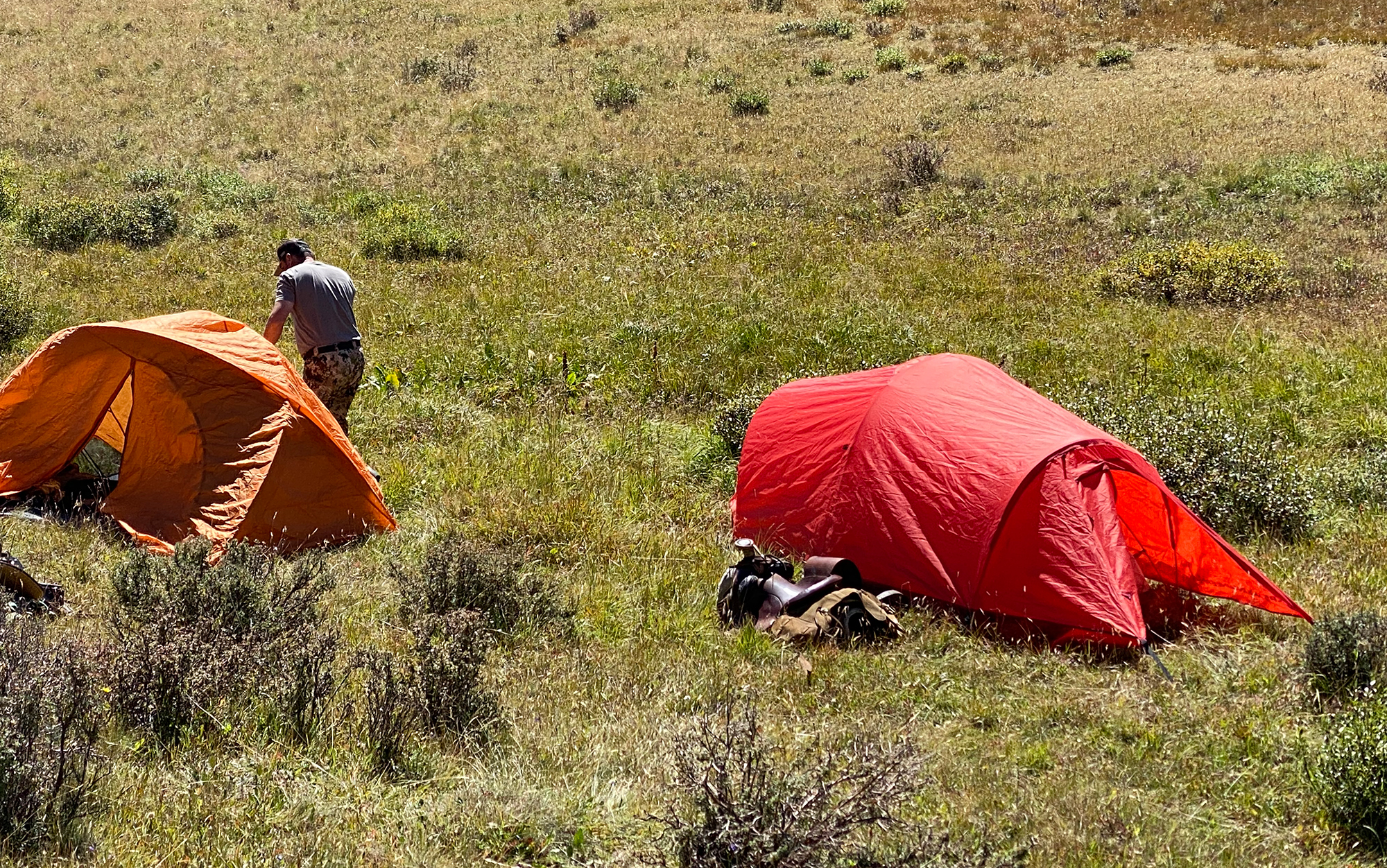
I will take a two-person tent over a one-person or bivy sack any day of the week. Comfort and rest are essential on a backcountry hunt, and I don’t want to feel like I’m in a coffin. With this tent, I have room for my gear and it fits easily in my backpack. Over the years, the tent has withstood extreme winds, torrential downpours, and an overnight September snow that dropped 3 feet of white. The tent is as durable as the day is long, and it will be with me on every elk excursion for years to come.
Read Next: Best Ultralight Tents
Best Knife: Benchmade Raghorn Carbon Fiber
Best Knife
Benchmade Raghorn Carbon Fiber
Pros
- Drop-point style blade
- Air-hardenable, non-stainless steel that’s tough as nails
- Sheath included
- Hand-assembled and razor-sharp
Cons
- Price
Key Features
- Overall Length: 8.88 inches
- Blade Length: 4 inches
- Cutting Edge: 4.125 inches
- Blade Thickness: 0.07 inch
- Blade Material: CPM Cru-wear
- Blade Style: Drop Point
- Blade Grind: Flat
- Handle Material: Carbon Fiber
- Weight: 1.67 ounces
When you get a bull on the ground, you’ll appreciate a good hunting knife more than ever. I don’t haul a saw in my pack, so I rely on my fixed-blade knife from Benchmade to get the job done. I prefer any make from Benchmade, but I’m a massive fan of their Raghorn Carbon Fiber.
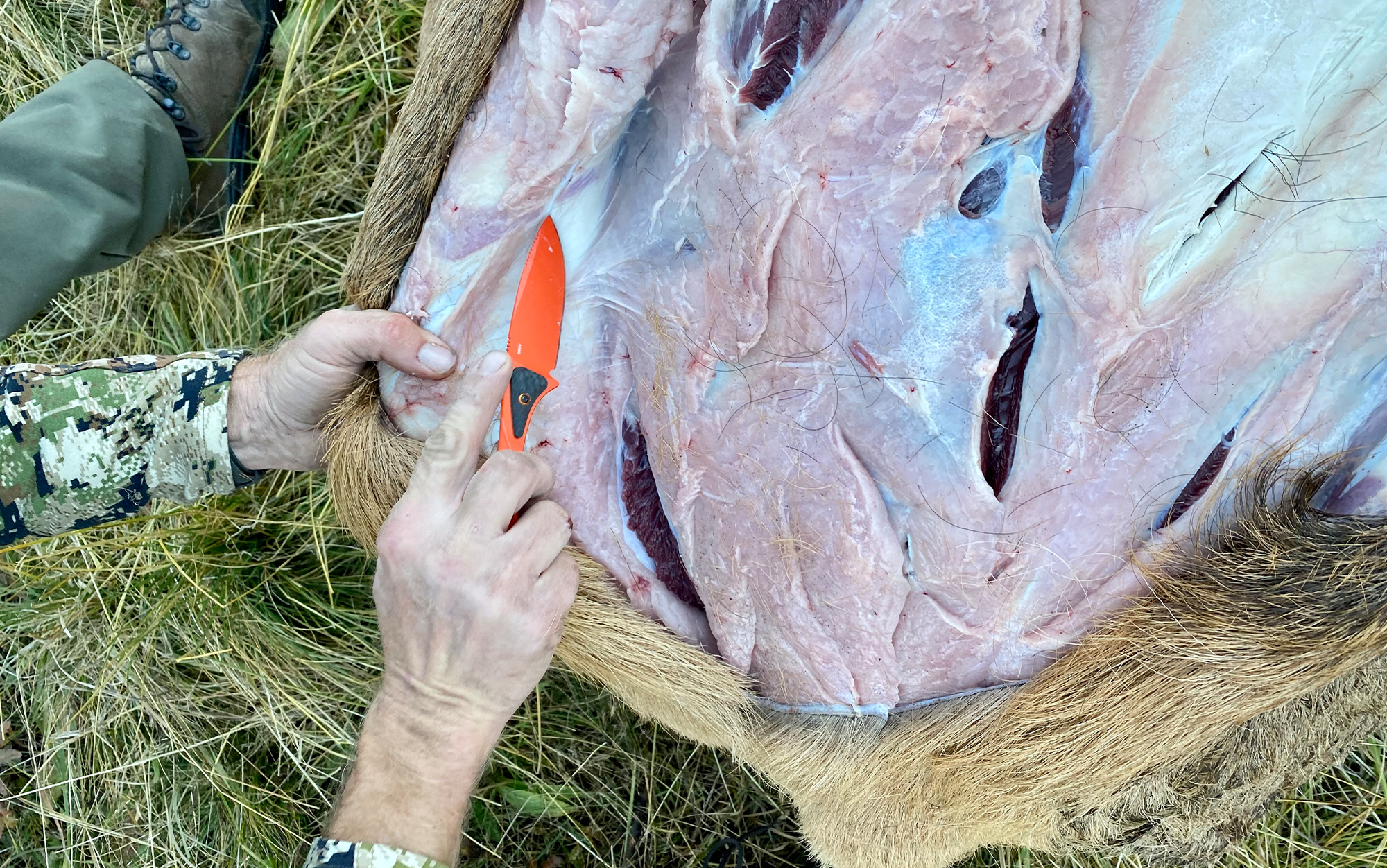
There is some sticker shock, but I promise, this is the last elk knife you’ll ever have to buy. This knife does everything from skinning to de-boning to caping and everything in between. The Raghorn is laser cut from CPM Cru-wear sheets, and you’ll love the lightweight and highly gripable carbon fiber handle. The blade holds its edge and sharpens quickly. This season, I broke down a pair of bulls with the knife, which still shaved the hair off my arm when I was done.
Best Calls: Rocky Mountain Hunting Calls Wapiti Whacker Bugle Tube and Black Magic GTP Diaphragm
Best Calls
Rocky Mountain Hunting Calls Wapiti Whacker Bugle Tube and Black Magic GTP Diaphragm
Pros
- Versatile calls
- Produce realistic elk tones
- Bugle tube has a fabric-wrapped cover to reduce game-spooking noise in transit
- Diaphragm features a Golden Plate Dome that ensures proper mouth positioning and ease-of-use
Cons
- The durability of the rubber rand on the bugle is sub-par
Key Features (Bugle Tube)
- Weight: 1.5 ounces
- Length: 20 inches
- Mouth Opening: 1 inch
- Made in USA
- Includes camo cover and lanyard
- V.E.T.T. Mouthpiece enlargement ring included for optional 1 1/2 inch mouthpiece opening
One of the many things that make elk such an addictive quarry is their vocality. I love calling elk, and for the past four years, I’ve had excellent success using the Wapiti Whacker Bugle Tube and Black Magic GTP diaphragm from Rocky Mountain Hunting Calls. The Black Magic is extremely versatile; I can create deafening challenge bulges, soft cow mews, and chirps. The Wapiti Whacker is easy to use, and if you take time to master your diaphragm calls, it will help you lure a love-sick bull into range.
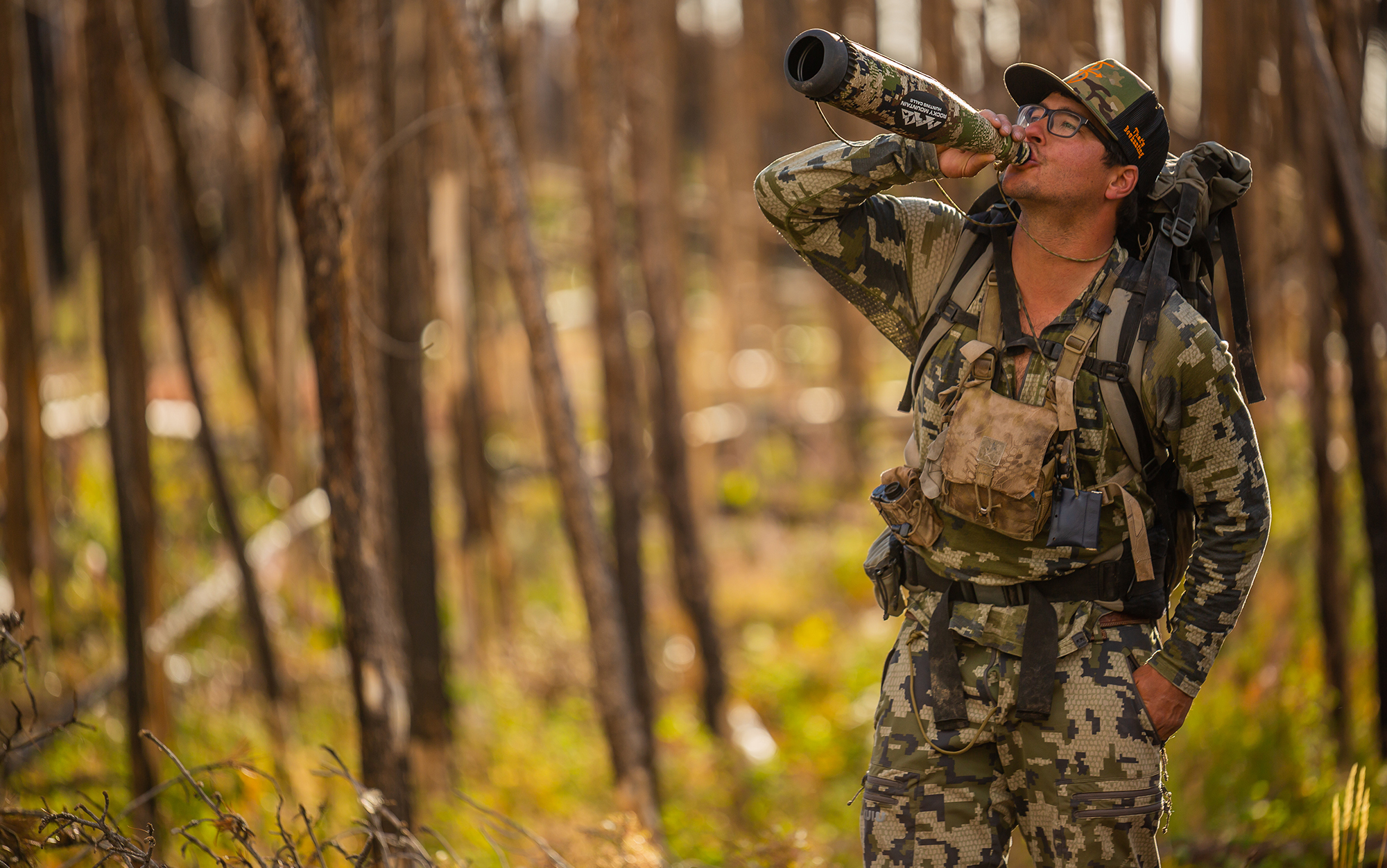
If I had only two elk calls to conquer the Rockies, it would be the Black Magic GTP and Wapiti Whacker Bugle. While I am a fan of changing tone and pitch by switching between diaphragms, I’ve had excellent success mastering a single diaphragm that allows me to make cow and bull talk. With this combo, I can rip a locator bugle, hit a challenge bugle, make a guttural glunk, or sound like a ready-to-breed cow. When you find a combo like this, buy multiple reeds and a replacement tube.
Read Next: Best Elk Calls
Best Decoy: Ultimate Predator Stalker Elk Decoy
Best Decoy
Ultimate Predator Stalker Elk Decoy
Pros
- Attaches to the top and bottom limbs of your compound bow
- Actual printed image of a cow elk
- Lightweight
- Links to the bow in seconds
Cons
- Difficult to use in the wind
Key Features
- Built in shooting window
- Durable, UV free, quick drying, micro suede fabric
- Total weight is less than 10 ounces
- Collapses to a 10-inch diameter disc
- Built-in orange safety strap
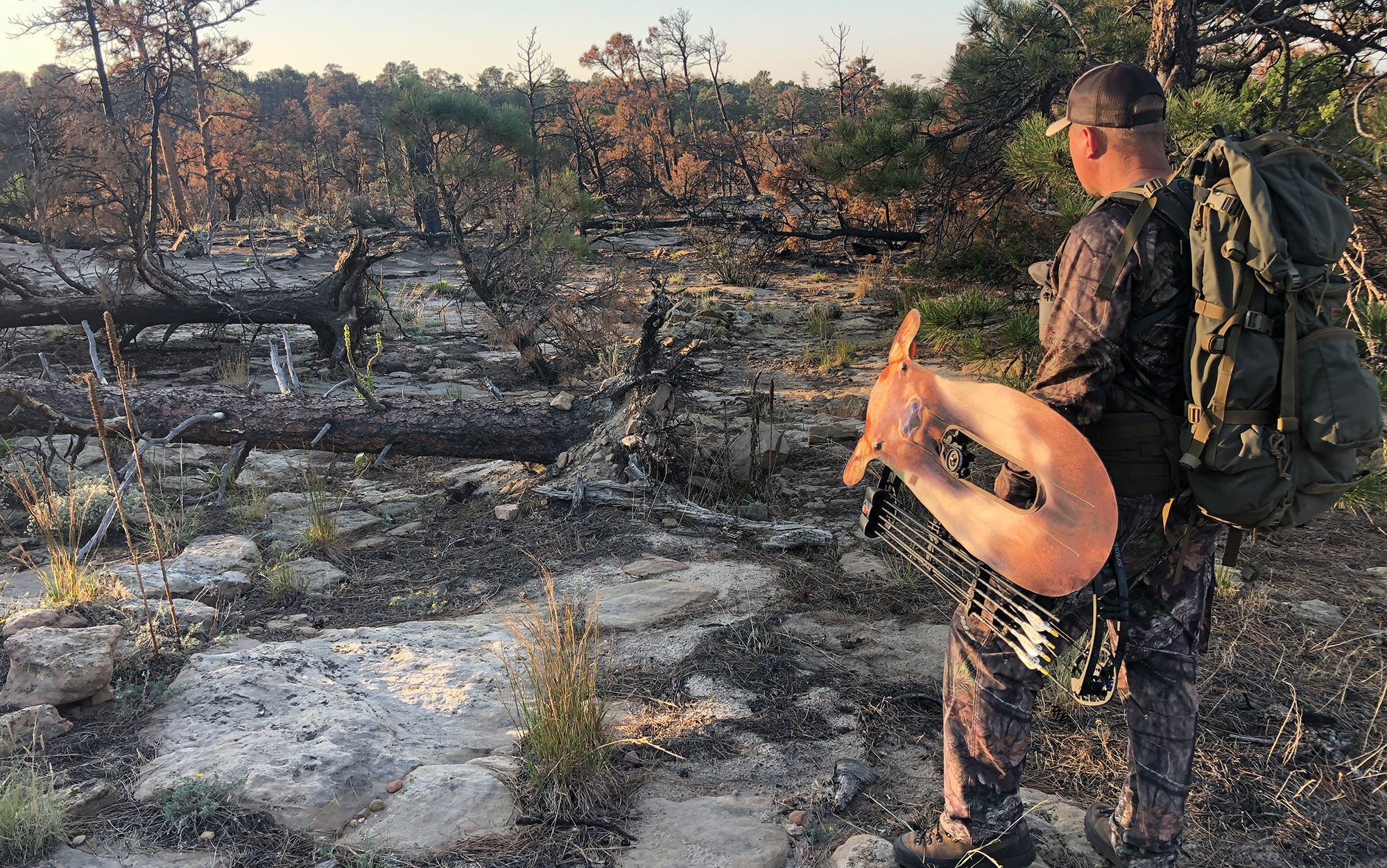
I’m a decoy nut, and a decoy is a must-have item when hunting elk solo. Elk, even young bulls with limited rut experience, are savvy. They get to a point when they feel like they should see the elk they are coming to investigate. When elk don’t get visual confirmation, the game is usually over. When you can give that bull visual confirmation by adding a Stalker elk decoy to your bow, chances are good he’ll keep coming, and you can seal the deal.
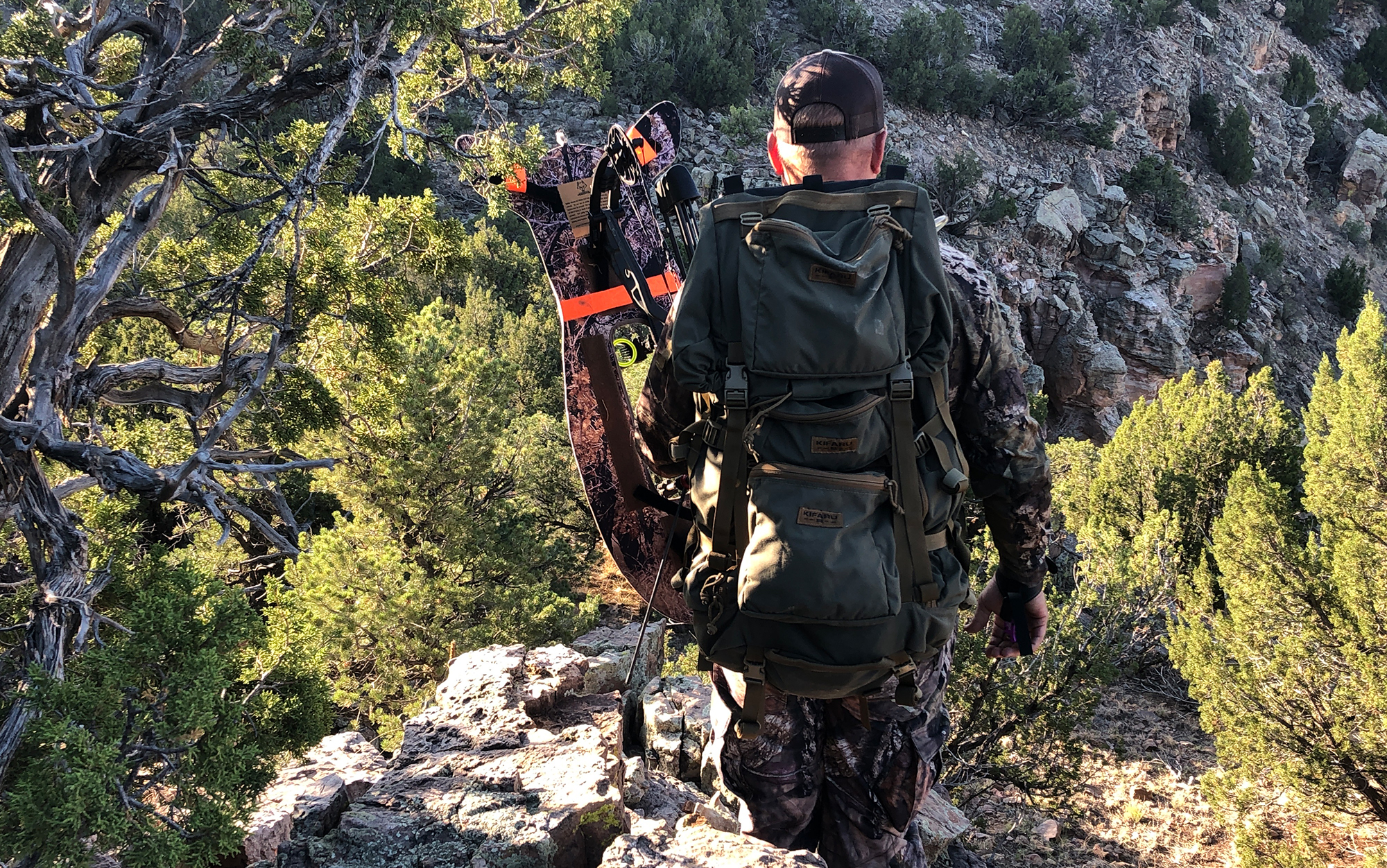
Mostly because I’ve killed a handful of bulls using the decoy. It’s something every elk hunter should have in their backpack. While I don’t recommend use during rifle or muzzleloader season on public land, this durable, UV-free, quick-drying, micro suede fabric elk fake attaches to the top and bottom limb of your bow via Velcro straps or other attachment systems sold by Ultimate Predator. The shoot-through window means you can hold your bow out in front of you and shoot right through the decoy’s middle. The decoy works remarkably well, and I don’t go into the elk woods without it.
Things to Consider Before Buying the Best Elk Hunting Gear
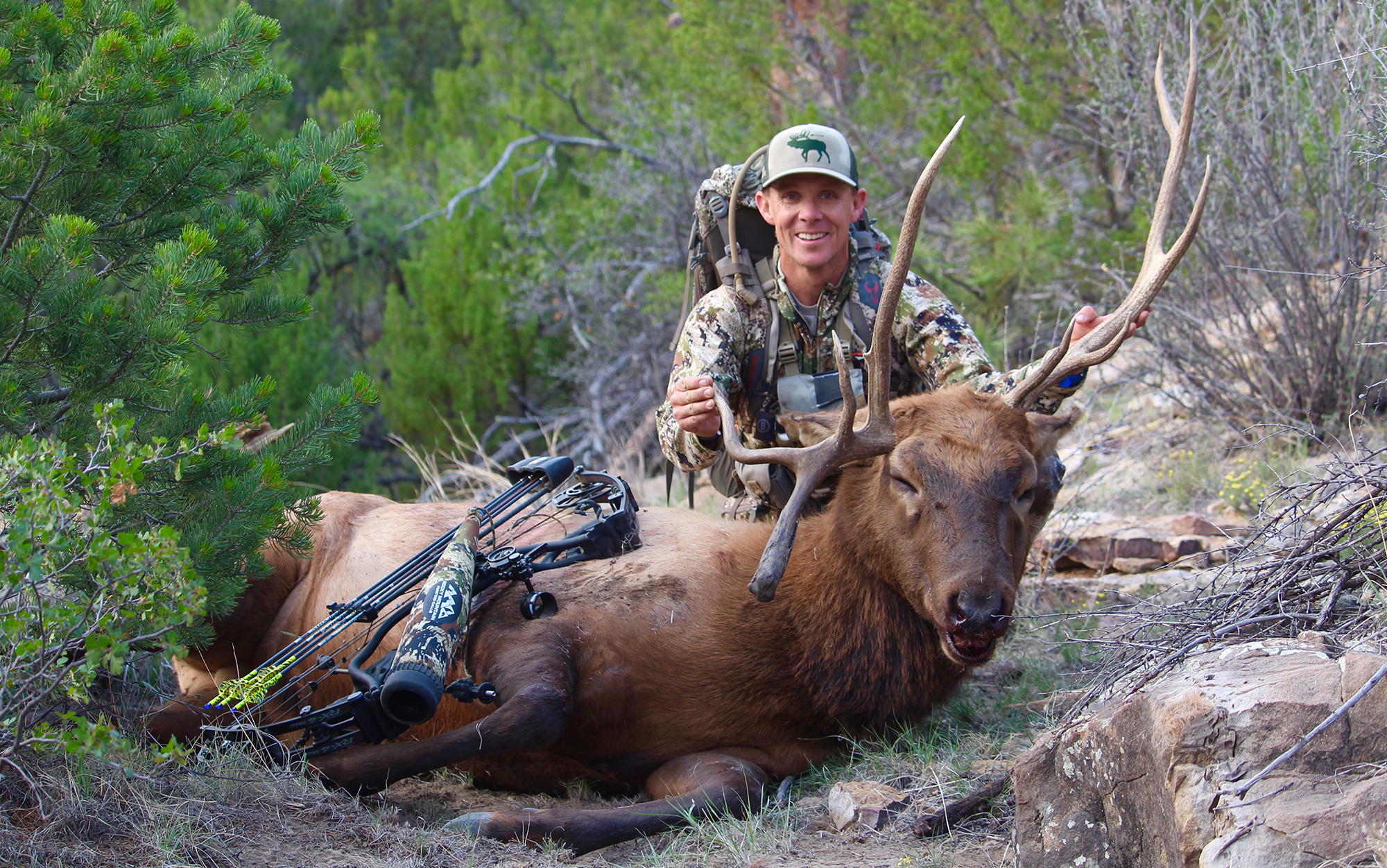
FAQs
This is a popular question. The answer deserves its own article, but I will do my best. What gear you take on an elk hunt is determined by the style of elk hunt you’re going on. For example, my go-deep backcountry elk gear list is much different from my hunt-from-camp gear. My gear also fluctuates by the terrain and time of year. My early November rifle elk gear is much different from my September archery choices. I will opt for certain gear when chasing elk in the sub-alpine and other gear when hunting them in low-land cedar-choked canyons. The most important thing to remember is to match your gear to your hunting style, terrain, and time of year.
If I know my elk mission is bonsai one, meaning I have a long weekend and nothing else, I go super light. You only have three days to get the job done, and likely, you’ll be covering a lot of country. For this reason, I select lightweight gear. Also, my food choice changes remarkably. When I go on a week-long or 10-day elk excursion food is paramount. I take in as many calories daily as possible so my body will withstand a lengthy hunt. I do the opposite on short elk missions. Of course, I eat, but because I know I will be back at the truck in three days, I don’t worry much about food. I take enough to keep pack weight down and get by. My food selection is simple—no pleasure or reward items—the basics to keep my nutrition and hydration up and nothing else.
Like any gear, pack size should be determined by hunt style and how long you plan to be in the elk woods. If I’m staying at a base camp that I return to each night, my pack choice is typically between 2,500 and 3,500 cubic inches. I want enough room to haul meat if I’m successful, but because I’m not hauling my sleep system, extra clothing, food, and the like, I don’t need an ultra-spacious pack. If I’m hunting off my back far from the trailhead and sleeping where I stop each night, I like a pack with a cubic-inch rating over 5,000.
Final Thoughts on the Best Elk Hunting Gear
The best elk gear will fluctuate from hunter to hunter, but make no mistake, the items mentioned above are excellent adds to any elk gear arsenal. Remember, in the world of top-end hunt gear, you get what you pay for. We train and work all year for one opportunity to take down a bull elk. One bad gear decision could make the difference between success and failure—between staying on the mountain for ten days or being forced off after three. Save your pennies, do your research, and build the best elk gear arsenal that you possibly can for the upcoming season.
- Best Boots: Kenetrek Mountain Extreme 400
- Best Backpack: ALPS Elite Frame + 3800 Pack
- Best Clothing: Sitka Kelvin Lite Down Jacket and Ascent Pant
- Best Tent: Alps Mountaineering Tasmanian 2-Person
- Best Knife: Benchmade Raghorn Carbon Fiber
- Best Calls: Rocky Mountain Hunting Calls Wapiti Whacker Bugle Tube and Black Magic GTP Diaphragm
- Best Decoy: Ultimate Predator Stalker Elk Decoy
